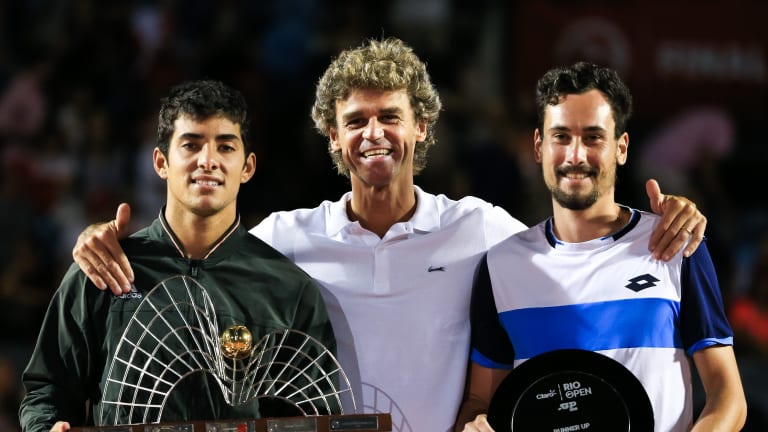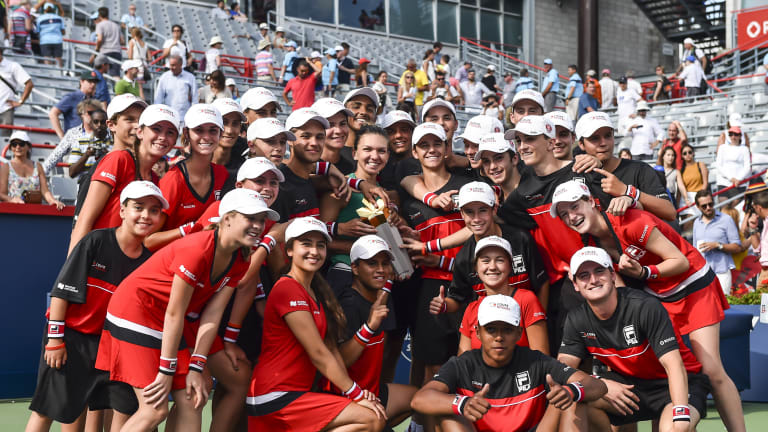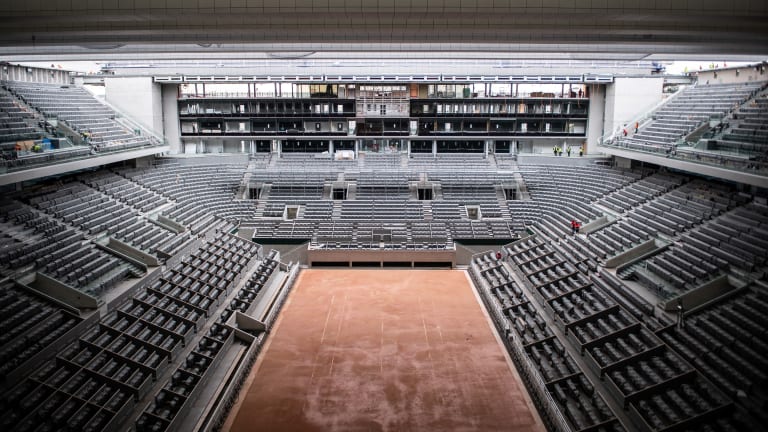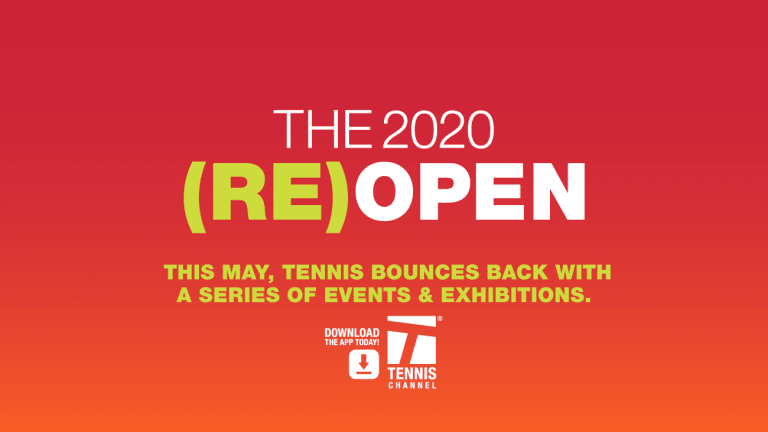Waiting game: Tournament directors brace for year lost down the drain
May 02, 2020"Don't know where I pulled that out of": Marcos Giron wins first ATP title in tense Newport finish
By TENNIS.com Jul 22, 2024American teenager Alex Michelsen ends Reilly Opelka's Newport comeback in semifinals
By TENNIS.com Jul 20, 2024Returning Reilly Opelka makes recent ATP history win run to Newport semifinals
By TENNIS.com Jul 19, 2024Adrian Mannarino wins Newport, ending great week for American teen Alex Michelsen
By Associated Press Jul 23, 2023Locked in: Alex Michelsen, 18, reaches Newport title match in second ATP main draw
By Joel Drucker Jul 22, 2023The 20-Year Age Gap: John Isner to battle red-hot teen Alex Michelsen in Newport semifinals
By TENNIS.com Jul 21, 2023Kevin Anderson to step out of retirement in Newport, 14 months after hanging up racquet
By TENNIS.com Jul 08, 2023Maxime Cressy edges Alexander Bublik on grass for first ATP title in Newport
By Associated Press Jul 17, 2022Andy Murray launches US Open seeding chase at Newport; to meet Alexander Bublik next
By Kamakshi Tandon Jul 13, 2022Waiting game: Tournament directors brace for year lost down the drain
While much talk surrounds player compensation and mergers—especially of late—the plight of tennis tournaments, and their future health, has somewhat been overlooked.
Published May 02, 2020
Advertising
Waiting game: Tournament directors brace for year lost down the drain
Like players, tournaments continue to suffer during the coronavirus-enforced tennis lockdown that has stretched to almost two months. Yes, it’s only officially been two months, but feels like an age.
Events on all three major surfaces have sustained heavyweight blows, beginning with the unofficial fifth Grand Slam of Indian Wells in March. And while much talk surrounds player compensation and tour mergers, the plight of tournaments has somewhat been overlooked.
TENNIS.com caught up with three tournament directors for their take, starting with one who could fall in the minority come 2020’s conclusion.
Luiz Carvalho suspects he encountered the coronavirus firsthand.
At home in Sao Paulo in March, he began suffering symptoms commonly associated with the illness that has jolted the world to a standstill.
“It was so bad,” Carvalho says. “I was sick for 10 days. The symptoms changed so fast. I had a fever for six or seven days, body aches, sore throat, lost the sense of smell, an ear ache. Every day was a new thing. I had some breathing issues so I went to the hospital.”
But unable to receive a test unless he was admitted, he said, Carvalho decided to return home, eventually recovering.
“I’m over it now,” the 38-year-old says.
Advertising
Like players, tournaments continue to suffer during the coronavirus-enforced tennis lockdown that has stretched to almost two months. Yes, it’s only officially been two months, but feels like an age.
Events on all three major surfaces have sustained heavyweight blows, beginning with the unofficial fifth Grand Slam of Indian Wells in March. And while much talk surrounds player compensation and tour mergers, the plight of tournaments has somewhat been overlooked.
TENNIS.com caught up with three tournament directors for their take, starting with one who could fall in the minority come 2020’s conclusion.
Luiz Carvalho suspects he encountered the coronavirus firsthand.
At home in Sao Paulo in March, he began suffering symptoms commonly associated with the illness that has jolted the world to a standstill.
“It was so bad,” Carvalho says. “I was sick for 10 days. The symptoms changed so fast. I had a fever for six or seven days, body aches, sore throat, lost the sense of smell, an ear ache. Every day was a new thing. I had some breathing issues so I went to the hospital.”
But unable to receive a test unless he was admitted, he said, Carvalho decided to return home, eventually recovering.
“I’m over it now,” the 38-year-old says.

Waiting game: Tournament directors brace for year lost down the drain
© Getty Images
Advertising
Cristian Garin captured February's Rio Open crown over Gianluca Mager. (Getty Images)
While he was struck down, two of his events, though, were spared. He heads the WTA’s International Shenzhen Open, in the first week of the season, and the men’s ATP 500 Rio Open in the middle of February. Carvalho—who briefly played pro tennis before working for the ATP in media relations—also occupies the same post at late September’s Chengdu Open, a 250-level event.
With Chengdu and the rest of the campaign looking uncertain in the absence of a vaccine or globally proven cure, Shenzhen and Rio might very well be two of the few tournaments completed this year.
“We were very lucky, especially Rio, very, very lucky,” says Carvalho. “Two weeks after the final, the ATP decided to stop the tour.
“It’s hard to feel any positive feelings about being able to finish the event when everybody else is suffering so many bad things with the virus. But I guess it’s a sense of relief and, yes, luck.”
Chinese state media reported the first death linked to the virus on Jan. 11, the same day Ekaterina Alexandrova beat Elena Rybakina in the Shenzhen finale in a battle of fast-rising players. Carvalho arrived back in Brazil a day later and sought constant updates from his Shenzhen staff, making calls and sending emails daily.
“At that point we didn’t think and maybe no one thought this would leave China,” says Carvalho. “We really thought this would be under control. We were concerned but not as concerned as we would be if we knew everything that was going to happen.”
The gigantic blow to the economy leaves Carvalho “very worried” for his events in 2021, particularly Rio. It relies on 30 sponsors and costs are higher in part because its home is a temporary structure, on the site of a jockey club picturesquely nestled beside a lagoon. Rio’s net profit, Carvalho added, doesn’t quite hit the $1.1 million average made by 500s as reported by the New York Times in March.
“We can’t afford to lose one sponsor,” Carvalho said. “It would impact heavily on our ability to run the event.”
Government funding props up his Chinese tournaments, both of which are staged at permanent sites. Shenzhen, Rio and Chengdu are bereft of insurance for pandemics, unlike already canceled Wimbledon, which, according to reports, could receive 100 million pounds ($124 million) after paying 1.5 million pounds for the policy.
“There’s a lot of talk in the ATP, WTA among the tournament directors of how to protect against something like this,” said Carvalho. “In Brazil, it’s really hard and very expensive to get insurance like this. Super expensive. So I’m not sure if we’d have taken the risk or not.”
Montreal’s Coupe Rogers, scheduled for August 10-16, didn’t opt for expensive pandemic insurance, either. But dissimilar to Shenzhen and Rio, the Premier 5 WTA spectacle couldn’t elude the virus, depriving home fans of seeing Canadian history-maker Bianca Andreescu.
Cancelation came the second week of April, after the province of Quebec’s government called for major events to be put off until August’s end, at the earliest. The city’s world-renowned jazz and comedy festivals also took the hit.

Waiting game: Tournament directors brace for year lost down the drain
© 2018 Getty Images
Advertising
Simona Halep topped Sloane Stephens in the 2018 Montreal final. (Getty Images)
The ATP Rogers Cup in Toronto the same week is expected to be scrapped, too, rocking Tennis Canada to the tune of $17 million Canadian ($12.2 million).
“It’s a tremendous blow,” says Montreal’s tournament director, Eugene Lapierre. “Both tournaments amount for over 90 percent of the revenues we make at Tennis Canada. That’s the complete year down the drain.
“They are the engine for the development of the game in Canada. That’s how we’re able to do all the programs we do, from school programs all the way up to the National Tennis Center (NTC) and the development of top athletes.”
Not long after Lapierre told TENNIS.com the governing body thus needed to “restructure” and “cut programs massively,” Tennis Canada dismissed 40 percent of its staff and intends to lay off another 30 percent. Remaining employees, continued Lapierre, saw their wages cut by 25 percent.
One of the most well-supported tournaments on the circuit, Montreal last year drew a record 223,000 spectators. Gate receipts, then sponsors and, lastly, television rights, comprise its three major sources of revenue. Lapierre hopes the crowds will return when the tennis does, but concedes his tournament needs to be rebuilt.
A veteran tennis administrator, the 64-year-old especially noted the virus due to its links to Wuhan. Lapierre visited the fellow Premier 5 WTA tournament there as part of a tennis conference in 2018.
“It was a nice visit so I could relate to that place and I was sensitive when I heard the name Wuhan,” he says.
The NTC in Montreal, a public facility holding nearly 30 courts where the likes of Milos Raonic and Felix Auger-Aliassime honed their skills, closed March 12.
“Starting March 13, pretty much everything was closed in Montreal and I think at that time people were optimistic things would settle before the summer,” says Lapierre, before pausing. “I was not.
“But we’ll come back. We have what it takes.”
Those longing for a grass-court fix this year had a solitary hope remaining in Newport’s Hall of Fame Open. The ongoing devastating effects of the virus, though, made it a considerable longshot.
“We basically deferred our marketing calendar,” says tournament director Todd Martin, the twice Grand Slam finalist who competed in the golden age of U.S. men’s tennis alongside Pete Sampras, Andre Agassi, Jim Courier and Michael Chang. “As the weather picks up, as the French Open is being played” in its normal slot of late May and early June, “we start to really intensify our sales efforts.”
“And so all of that is on hold because it’s silly to spend money at this moment trying to make sales to a market that’s not interested in spending money at this moment.”

Waiting game: Tournament directors brace for year lost down the drain
© All Rights Reserved 2019
Advertising
Mary Pierce was inducted in 2019, along with Li Na and Yegeny Kafelnikov. (Getty Images)
Not spending money—and losing it. The Hall of Fame’s sprawling and multifunctional site, which includes a 12,000 square foot museum, tennis club and hospitality suites, has been shut for about six weeks.
“If everything went swimmingly other than those couple of months, we would be hit hard, the Hall of Fame’s business would be hit hard,” says Martin, also the International Tennis Hall of Fame’s CEO.
“And certainly not having a tournament, or having a tournament that’s significantly compromised by the health crisis, will be devastating for the Hall of Fame in 2020. It wouldn’t impact our ability to host the tournament or interest to host it next year, but we would have to do a lot of work—a lot of work—to stabilize the ship.”
Martin expected to learn his event’sfate from the ATP by the middle of May. But on April 29, Rhode Island's state government banned large events scheduled during summer months. Martin's team remains on hold with determining a best course of action until the tour makes its next calendar announcement.
"Although our Hall of Fame Enshrinement Weekend is not linked to any ATP Tour decision, we have decided to wait until then to address plans for the Induction Ceremony and weekend events as well, because the tournament and enshrinement event tickets are sold together," the tournament announced Thursday. "This is in the interest of simplicity for processing ticket deferrals, donations, or refunds for our patrons."

Waiting game: Tournament directors brace for year lost down the drain
© AFP via Getty Images
Advertising
Court Philippe Chatrier will debut a brand new roof, whenever Roland Garros is next held. (Getty Images)
Meanwhile, Carvalho awaits the fate of Chengdu, scheduled for September 28 through October 4. The commencement of the men’s Asian swing with Zhuhai now conflicts with the French Open’s readjusted spot on the calendar of September 20-October 4.
Chatter of Roland Garros being pushed back another week still wouldn’t eliminate the direct conflict. Carvalho got wind of the French Open’s decision on Twitter. As it came in the midst of his illness, he initially thought he was imagining things.
“I was on the couch. I said, ‘This is not true. I’m delusional.’ And then obviously it was true,” says Carvalho. “I’m sure no one wants to be scheduled against Roland Garros. It was very frustrating and disrespectful, but when you look at the facts behind it, we kind of began to understand their minds and their desperation.”
If the year’s clay-court major isn’t held, the French Open stands to lose about 260 million euros ($283 million), L’Equipe reported in March.
Carvalho’s planning for Chengdu, and on its current dates, continues. A move is presumably preferable—and possible. The weather allows for Chengdu to be contested as late as the end of October.
“The ATP and WTA in their own ways are working on different types of schedules,” said Carvalho. “We have weekly calls to discuss it. Basically we are going to see what the options are.”
A variety of possible options is about all tournament directors have to cling to in this tumultuous time.

Waiting game: Tournament directors brace for year lost down the drain
Advertising

Waiting game: Tournament directors brace for year lost down the drain
© Getty Images
Cristian Garin captured February's Rio Open crown over Gianluca Mager. (Getty Images)
While he was struck down, two of his events, though, were spared. He heads the WTA’s International Shenzhen Open, in the first week of the season, and the men’s ATP 500 Rio Open in the middle of February. Carvalho—who briefly played pro tennis before working for the ATP in media relations—also occupies the same post at late September’s Chengdu Open, a 250-level event.
With Chengdu and the rest of the campaign looking uncertain in the absence of a vaccine or globally proven cure, Shenzhen and Rio might very well be two of the few tournaments completed this year.
“We were very lucky, especially Rio, very, very lucky,” says Carvalho. “Two weeks after the final, the ATP decided to stop the tour.
“It’s hard to feel any positive feelings about being able to finish the event when everybody else is suffering so many bad things with the virus. But I guess it’s a sense of relief and, yes, luck.”
Chinese state media reported the first death linked to the virus on Jan. 11, the same day Ekaterina Alexandrova beat Elena Rybakina in the Shenzhen finale in a battle of fast-rising players. Carvalho arrived back in Brazil a day later and sought constant updates from his Shenzhen staff, making calls and sending emails daily.
“At that point we didn’t think and maybe no one thought this would leave China,” says Carvalho. “We really thought this would be under control. We were concerned but not as concerned as we would be if we knew everything that was going to happen.”
The gigantic blow to the economy leaves Carvalho “very worried” for his events in 2021, particularly Rio. It relies on 30 sponsors and costs are higher in part because its home is a temporary structure, on the site of a jockey club picturesquely nestled beside a lagoon. Rio’s net profit, Carvalho added, doesn’t quite hit the $1.1 million average made by 500s as reported by the New York Times in March.
“We can’t afford to lose one sponsor,” Carvalho said. “It would impact heavily on our ability to run the event.”
Government funding props up his Chinese tournaments, both of which are staged at permanent sites. Shenzhen, Rio and Chengdu are bereft of insurance for pandemics, unlike already canceled Wimbledon, which, according to reports, could receive 100 million pounds ($124 million) after paying 1.5 million pounds for the policy.
“There’s a lot of talk in the ATP, WTA among the tournament directors of how to protect against something like this,” said Carvalho. “In Brazil, it’s really hard and very expensive to get insurance like this. Super expensive. So I’m not sure if we’d have taken the risk or not.”
Montreal’s Coupe Rogers, scheduled for August 10-16, didn’t opt for expensive pandemic insurance, either. But dissimilar to Shenzhen and Rio, the Premier 5 WTA spectacle couldn’t elude the virus, depriving home fans of seeing Canadian history-maker Bianca Andreescu.
Cancelation came the second week of April, after the province of Quebec’s government called for major events to be put off until August’s end, at the earliest. The city’s world-renowned jazz and comedy festivals also took the hit.
Advertising

Waiting game: Tournament directors brace for year lost down the drain
© 2018 Getty Images
Simona Halep topped Sloane Stephens in the 2018 Montreal final. (Getty Images)
The ATP Rogers Cup in Toronto the same week is expected to be scrapped, too, rocking Tennis Canada to the tune of $17 million Canadian ($12.2 million).
“It’s a tremendous blow,” says Montreal’s tournament director, Eugene Lapierre. “Both tournaments amount for over 90 percent of the revenues we make at Tennis Canada. That’s the complete year down the drain.
“They are the engine for the development of the game in Canada. That’s how we’re able to do all the programs we do, from school programs all the way up to the National Tennis Center (NTC) and the development of top athletes.”
Not long after Lapierre told TENNIS.com the governing body thus needed to “restructure” and “cut programs massively,” Tennis Canada dismissed 40 percent of its staff and intends to lay off another 30 percent. Remaining employees, continued Lapierre, saw their wages cut by 25 percent.
One of the most well-supported tournaments on the circuit, Montreal last year drew a record 223,000 spectators. Gate receipts, then sponsors and, lastly, television rights, comprise its three major sources of revenue. Lapierre hopes the crowds will return when the tennis does, but concedes his tournament needs to be rebuilt.
A veteran tennis administrator, the 64-year-old especially noted the virus due to its links to Wuhan. Lapierre visited the fellow Premier 5 WTA tournament there as part of a tennis conference in 2018.
“It was a nice visit so I could relate to that place and I was sensitive when I heard the name Wuhan,” he says.
The NTC in Montreal, a public facility holding nearly 30 courts where the likes of Milos Raonic and Felix Auger-Aliassime honed their skills, closed March 12.
“Starting March 13, pretty much everything was closed in Montreal and I think at that time people were optimistic things would settle before the summer,” says Lapierre, before pausing. “I was not.
“But we’ll come back. We have what it takes.”
Those longing for a grass-court fix this year had a solitary hope remaining in Newport’s Hall of Fame Open. The ongoing devastating effects of the virus, though, made it a considerable longshot.
“We basically deferred our marketing calendar,” says tournament director Todd Martin, the twice Grand Slam finalist who competed in the golden age of U.S. men’s tennis alongside Pete Sampras, Andre Agassi, Jim Courier and Michael Chang. “As the weather picks up, as the French Open is being played” in its normal slot of late May and early June, “we start to really intensify our sales efforts.”
“And so all of that is on hold because it’s silly to spend money at this moment trying to make sales to a market that’s not interested in spending money at this moment.”
Advertising

Waiting game: Tournament directors brace for year lost down the drain
© All Rights Reserved 2019
Mary Pierce was inducted in 2019, along with Li Na and Yegeny Kafelnikov. (Getty Images)
Not spending money—and losing it. The Hall of Fame’s sprawling and multifunctional site, which includes a 12,000 square foot museum, tennis club and hospitality suites, has been shut for about six weeks.
“If everything went swimmingly other than those couple of months, we would be hit hard, the Hall of Fame’s business would be hit hard,” says Martin, also the International Tennis Hall of Fame’s CEO.
“And certainly not having a tournament, or having a tournament that’s significantly compromised by the health crisis, will be devastating for the Hall of Fame in 2020. It wouldn’t impact our ability to host the tournament or interest to host it next year, but we would have to do a lot of work—a lot of work—to stabilize the ship.”
Martin expected to learn his event’sfate from the ATP by the middle of May. But on April 29, Rhode Island's state government banned large events scheduled during summer months. Martin's team remains on hold with determining a best course of action until the tour makes its next calendar announcement.
"Although our Hall of Fame Enshrinement Weekend is not linked to any ATP Tour decision, we have decided to wait until then to address plans for the Induction Ceremony and weekend events as well, because the tournament and enshrinement event tickets are sold together," the tournament announced Thursday. "This is in the interest of simplicity for processing ticket deferrals, donations, or refunds for our patrons."
Advertising

Waiting game: Tournament directors brace for year lost down the drain
© AFP via Getty Images
Court Philippe Chatrier will debut a brand new roof, whenever Roland Garros is next held. (Getty Images)
Meanwhile, Carvalho awaits the fate of Chengdu, scheduled for September 28 through October 4. The commencement of the men’s Asian swing with Zhuhai now conflicts with the French Open’s readjusted spot on the calendar of September 20-October 4.
Chatter of Roland Garros being pushed back another week still wouldn’t eliminate the direct conflict. Carvalho got wind of the French Open’s decision on Twitter. As it came in the midst of his illness, he initially thought he was imagining things.
“I was on the couch. I said, ‘This is not true. I’m delusional.’ And then obviously it was true,” says Carvalho. “I’m sure no one wants to be scheduled against Roland Garros. It was very frustrating and disrespectful, but when you look at the facts behind it, we kind of began to understand their minds and their desperation.”
If the year’s clay-court major isn’t held, the French Open stands to lose about 260 million euros ($283 million), L’Equipe reported in March.
Carvalho’s planning for Chengdu, and on its current dates, continues. A move is presumably preferable—and possible. The weather allows for Chengdu to be contested as late as the end of October.
“The ATP and WTA in their own ways are working on different types of schedules,” said Carvalho. “We have weekly calls to discuss it. Basically we are going to see what the options are.”
A variety of possible options is about all tournament directors have to cling to in this tumultuous time.
Advertising

Waiting game: Tournament directors brace for year lost down the drain